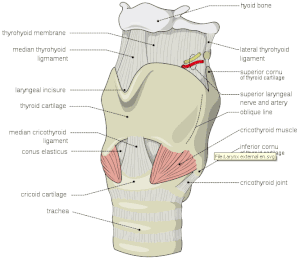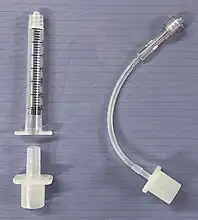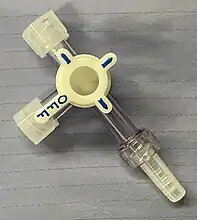Percutaneous translaryngeal ventilation
| Percutaneous translaryngeal ventilation | |
|---|---|
| Other names: Percutaneous transtracheal jet ventilation (PTJV); jet ventilation; needle cricothyrotomy; percutaneous transtracheal ventilation | |
 | |
| In needle cricothyrotomy, the puncture is made through the cricothyroid membrane, between the thyroid and cricoid cartilage. | |
| Specialty | Emergency medicine |
| Indications | Unable to intubate or ventilate a young child[1] |
| Contraindications | Tracheal transection, larynx fracture[1] |
| Steps | 1) Clean and freeze the area (if time)[1] 2) Place a needle through the cricothyroid membrane towards the lungs[1] 3) Once in the airway, slide the catheter off the needle[1] 4) Provide oxygen over 1 second using a bag valve mask or jet ventilator with 4 seconds for expiration[1] 5) Secure the catheter with a suture or tape[1] |
| Complications | Catheter misplacement or blockage, bleeding, subcutaneous emphysema, pneumothorax, pneumomediastinum, vocal cord injury, esophageal perforation, laryngeal cartilages injury[1] |
Percutaneous translaryngeal ventilation (PTLV), also known as needle cricothyrotomy, is the delivery of oxygen to the lungs through an over-the-needle catheter inserted through the skin of the neck into the trachea.[2] It is typically done in young children, instead of surgical cricothyrotomy, in a cannot intubate cannot ventilate situation.[1] What counts as young varies from under 5 to under 12 years old.[1] It is also used as part of anesthesia for laryngeal surgery.[1]
The procedure involves placing a large needle through the cricothyroid membrane (CTM) directed towards the lungs.[1] Once in place the catheter is slid off the needle into the airway.[1] Oxygen is then delivered by high pressure jet ventilator or bag valve mask.[1] If using a bag valve mask intravenous tubing and a 2.5 endotracheal tube adapter is used to connect the components.[2] Oxygen is briefly given with great time provided for air to exit the lungs.[1]
The catheter may be sutured or tied into place.[1] Capnography can be used to verify it is in the correct place.[1] Complications may include catheter misplacement or blockage, bleeding, subcutaneous emphysema, pneumothorax, pneumomediastinum, vocal cord injury, esophageal perforation, and laryngeal cartilages injury.[1] Over time respiratory acidosis may develop.[2] As the procedure is rarely performed, having the equipment preprepared and doing simulation is important.[2]
Medical uses
It is typically done in young children instead of surgical cricothyrotomy in a cannot intubate cannot ventilate situation.[1] It; however, may also be carried out in adults.[2]
While historically the procedure has been deemed to only be suitable for 30 to 45 minutes in adults, with intermittent rather than continuous oxygen flow it may be effective for longer.[1]
Once percutaneous translaryngeal ventilation, tracheal intubation becomes easier.[1]
Contraindications
The procedure cannot be done in someone with complete tracheal transection when the lower part of the trachea has moved into the chest.[1] It is also not generally recommended in someone with a larynx fracture.[1] If there is significant neck swelling the procedure also becomes more difficult.[1]
Technique
The person is placed on their back with their neck extended.[1] If sufficient time, the neck may be cleaned and frozen with lidocaine/epinephrine.[1]
The procedure involves placing a large needle through the cricothyroid membrane directed towards the lungs.[1] Placement between tracheal rings may also be done.[1]
Once air is reached the catheter is slid off the needle into the airway.[1] A 12 gauge or 14 gauge catheter is generally used.[2] Other types of catheters are also possible.[2]
Four to five times longer (5 seconds) should be provided for breathing out than instilling oxygen (1 second).[1] Previously a continuous flow of oxygen was used; however, while this provides oxygen it does not support the elimination of carbon dioxide.[2]
Jet ventilator

This method is preferred in those over the age of 5 years.[2] If a jet ventilator is used, this may be attached directly to the oxygen wall outlet in those over the age of 12 or to an oxygen regulator delivering about 12 l/min.[1]
Bag valve mask
This method is preferred in those under the age of 5 years.[2] If using a bag valve mask a 3 mL syringe with the plunger removed and a 7.0-mm adult endotracheal tube adapter is used to connect the components.[1] Another option is a short cut off piece of intravenous tubing and a 2.5-mm endotracheal tube adapter.[2]
 One possible set of equipment for a needle cricothyrotomy includes a bag valve mask, 3 ml syringe with the plunger removed, 7.0-mm adult endotracheal tube adapter, and 14-gauge angiocatheter.
One possible set of equipment for a needle cricothyrotomy includes a bag valve mask, 3 ml syringe with the plunger removed, 7.0-mm adult endotracheal tube adapter, and 14-gauge angiocatheter. Assembly of this equipment
Assembly of this equipment Comparison of the two connector methods, with the intravenous tubing and a 2.5 endotracheal tube adapter on the right
Comparison of the two connector methods, with the intravenous tubing and a 2.5 endotracheal tube adapter on the right
Three way stopcock
Another option is to use a three way stopcock with all ports open, attached to the oxygen tubing and to the catheter in the person's neck.[2] Oxygen is then provided at 1 l/min multiplied by the age of the children or at the maximum for adults.[2] The open port can than be blocked and released for inspiration and expiration.[2]
 A three way stopcock, a little stiff to turn, but can be turned to all ports open
A three way stopcock, a little stiff to turn, but can be turned to all ports open The equipment assembled with high pressure oxygen tubing
The equipment assembled with high pressure oxygen tubing
Society and culture
Availability
Manufactured kits with all the required equipment may be purchased.[1] Otherwise they can be assembled from material already available in an emergency department.[2] This should be done before it is potentially needed, such that everything is together if it does become required.[2]
Terminology
Percutaneous transtracheal ventilation may be mistaken for transtracheal jet ventilation, which is not considered conventional ventilation and refers to high-frequency ventilation; a low tidal volume ventilation that needs specialized ventilators only available in critical care units.
References
- 1 2 3 4 5 6 7 8 9 10 11 12 13 14 15 16 17 18 19 20 21 22 23 24 25 26 27 28 29 30 31 32 33 Mace SE, Khan N (2008). "Needle cricothyrotomy". Emerg Med Clin North Am. 26 (4): 1085–101, xi. doi:10.1016/j.emc.2008.09.004. PMID 19059102. Archived from the original on 2021-08-28. Retrieved 2022-03-14.
- 1 2 3 4 5 6 7 8 9 10 11 12 13 14 15 16 Roberts and Hedges' clinical procedures in emergency medicine and acute care (Seventh ed.). Philadelphia, PA: Elsevier Health Sciences. 2019. p. 136. ISBN 9780323547949.
External links
- A none safety 14 gauge needle Archived 2023-03-28 at the Wayback Machine
- A commercially available kit Archived 2023-06-06 at the Wayback Machine